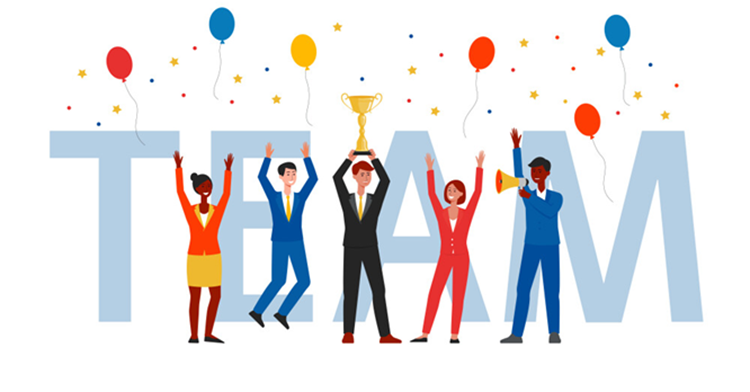Individual recognition boosts morale, encourages personal growth, and reinforces specific behaviors.
Team recognition fosters collaboration, unity, and a strong sense of belonging.
Both methods have their drawbacks, including bias, unhealthy competition, and overlooked contributions.
A balanced approach combining both, based on context and culture, yields the best results.
Employee recognition has become the buzzword in modern workplaces, thanks to its numerous benefits. Acknowledging and appreciating employee efforts and behaviors in a timely and effective manner drives productivity, boosts workforce engagement, and creates a positive work culture. While it is important to recognize individual efforts and achievements, appreciating entire teams is equally essential.

Recognizing individual employees through spot recognition, such as Employee of the Month, is essential for making them feel valued and boosting their self-confidence and morale. It also proves effective for reinforcing desired behaviors and skills that can help enhance organizational growth and profitability.
When organizations appreciate employees for their unique traits and achievements, they feel motivated to keep giving their best.

On the other hand, recognizing teams helps foster a sense of community within the workforce. When organizations recognize teams, they promote a sense of unity and collaboration among the members.
Team recognition can strengthen the sense of mutual trust and respect, motivating employees at different levels to work collaboratively and coordinate effectively.

Individual recognition focuses on acknowledging and appreciating the unique skills, behaviors, and achievements of a single employee. Individual employees may receive recognition for their efforts and contributions within a team or the organization. They may receive formal or informal rewards, as well as public or private appreciation.
As mentioned, individual recognition is essential in boosting morale and motivating employees. It helps foster a sense of belonging and makes the employees feel worthy and proud.
Recognizing individual performance helps build a highly engaged, driven, and efficient workforce. It also creates a positive work culture and a pleasing work environment.

Team recognition occurs when an organization acknowledges and appreciates the collective efforts and contributions of a group of employees as a single unit. This recognition method appreciates every team member equally and fosters a sense of shared success and cooperative working. Like individual recognition, organizations can use various methods to recognize teams and make them feel valued.
Regardless of how organizations choose to recognize teams, it can play a significant role in improving the overall work environment.
Team awards help strengthen the sense of community and belonging within the workforce, inspiring mutual trust and respect. They also help reinforce the value of teamwork and collaboration, promoting a culture of growth while strengthening camaraderie among employees.

| Advantages of Individual Recognition | Advantages of Team Recognition |
| 1. Boosts Motivation: Recognizing employees for their contributions keeps them motivated for a long time. They feel a deep sense of commitment to the organization, which inspires them to give their best consistently. | 1. Enhances Workforce Morale & Motivation: Recognizing team efforts and contributions helps boost the morale of every team member. It inspires the entire workforce and improves overall business productivity and efficiency. |
| 2. Improves Engagement: When employees are recognized individually, they feel valued and cared for. It fills them with a sense of belonging, and they are motivated to contribute more to the business. | 2. Promotes Teamwork & Collaboration: Rewarding employees for working collectively towards the fulfillment of common goals and tasks fosters a deep sense of collaboration and teamwork. |
| 3. Establishes Clear Performance Standards: Recognizing individual employees for specific achievements and behaviors sends a strong and clear message to the others about what the organization expects from them. | 3. Improves Talent Retention: Team recognition fosters a sense of community, making employees feel like part of a family. It discourages them from seeking options elsewhere and leaving their teammates behind, which significantly improves talent retention. |
| 4. Promotes Personal Development: Individual recognition promotes employees’ personal development and growth. It motivates them to keep learning and align their behaviors with the company’s culture and values. | 4. Helps Build Camaraderie: Recognizing teams is an effective way to strengthen the bonding between team members. It helps build friendships and bonding between coworkers. |
| 5. Increases Job Satisfaction: Individual recognition can improve employees’ job satisfaction. It assures them that their work and contributions matter, filling them with a sense of contentment and pride. | 5. Reduces Unhealthy Competition: Team recognition helps reduce unhealthy competition between coworkers. Team members do not feel left out and are inspired to contribute more to the team’s performance. |

| Disadvantages of Individual Recognition | Disadvantages of Team Recognition |
| 1. May Lead to Unhealthy Competition: Individual recognition may lead to unhealthy competition between co-workers. Employees who are not recognized may feel left out and resort to unethical means and practices. | 1. May Hinder Employees From Taking Initiative: Team recognition may discourage employees from taking initiative due to the fear that their efforts may not be valued enough. |
| 2. Can Breed Jealousy & Discontent: Recognising specific individuals can breed jealousy and discontent within the workforce. Especially, if the process is not transparent, it may lead others to doubt its authenticity. | 2. Overlooks Individual Efforts: It often overlooks the efforts and contributions of individual team members. Consequently, employees who work the hardest in the team may feel disappointed about not receiving a separate award. |
| 3. Makes Employees Feel Pressurized: Individual recognition often puts employees in the spotlight, making them feel pressured to give their best consistently. It can impact their physical, mental, and even emotional well-being. | 3. Fewer Opportunities for Personal Development: Employees often lack motivation to independently upgrade their knowledge and skills, which can hinder their personal and professional growth. |
| 4. Increased Risk of Bias and Favoritism: Individual recognition often carries a significantly higher risk of bias and favoritism. Managers or peers may nominate or recognize employees they prefer rather than those who genuinely deserve recognition. | 4. Increases the Risk of Freeloaders: Team recognition can be beneficial for employees who make minimal effort, as they receive praise and appreciation without necessarily deserving it. However, this might lower the morale of other members who have contributed more. |

Whether companies should opt for individual or team recognition depends on various circumstantial factors. The most important of these are as follows.
1. What is being recognized: Team recognition is the best option for functions requiring multiple employees’ skills and expertise. Individual recognition should be provided for tasks that require the unique skills of a single employee.
2. Organizational culture: Individual recognition is most effective in organizations with a competitive culture, while team recognition is more suitable for organizations with a collaborative culture.
3. The short- and long-term impact: Balancing both modes enhances the effectiveness of the employee recognition program, helping organizations achieve consistent results over a sustained period.
4. Personal preferences of most employees: Contrary to popular belief, not all top-performing employees prefer individual recognition, and vice versa.
We recommend that organizations utilize both individual and team recognition in a balanced and coordinated manner. This is the key to building a great workforce that feels truly valued and appreciated and is driven to give its best.

Lead author: Sagar Chaudhuri, the Co-Founder and CEO of HiFives. He is an HR Tech Evangelist with over 25 years of experience in both corporate and entrepreneurial settings. Previously, Sagar has held leadership roles with companies such as Genpact, Infosys, and ICICI Bank. He has an engineering degree from IIT Kharagpur and an MBA from IIM Lucknow. Connect on LinkedIn
To stay updated on the latest HiFives blogs, follow us on Twitter (@MyHiFives)